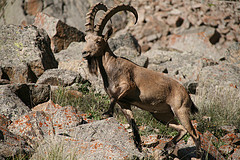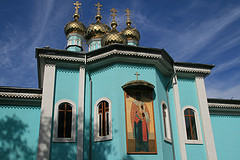Switching ‘Stans
Friday, August 28th, 2009It’s been almost a week since we left Kyrgyzstan, and although we once again didn’t do a great deal in our final week in Bishkek as Wendy prepared for her interview and then spent a whirlwind 60 hours going to Geneva and back, I feel as though I should wrap up the country a bit. The highlights since my last post were the Soviet-era State Historical Museum, with its Lenin shrine and anti-American propaganda – a fascinating insight into the way the Soviet Union presented itself to its citizens – and our overnight trek above the Ala-Archa Canyon, where we saw a glacier (albeit a dirty one) and three up-close Marco Polo sheep, the largest sheep species in the world and so named because they were mentioned by the Italian explorer (and, since he failed to mention the Great Wall of China, he must have been rather impressed by the sheep … as were we).
In the end, I spent a personal record of 19 nights in three different stints in Bishkek, all at the fabulous Sakura Guesthouse. Sakura was a haven within the city for us, and we needed the downtime that it afforded. The guesthouse owner (Sakura’s mother) is an intelligent woman who speaks four languages, understands what travellers want, has done a great job building the annex to turn the place into a true guesthouse, and looked after me when Wendy was gone (making me dinner and washing my clothes!). She also knows how to find mentions of her guesthouse on the web, and as such told me that she read the previous entry of this blog, much to my surprise!
After 40 days in Kyrgyzstan, last Saturday we finally left for Kazakhstan, which became our backup plan a few weeks ago when Wendy was denied a visa for Tajikistan. The comfortable minibus ride from Bishkek to Almaty took about four-and-a-half hours, and the border formalities were surprisingly easy and efficient.
It’s fashionable among guidebooks and Teds to describe Almaty as ‘almost European’, and while it’s certainly more developed and enjoyable to walk around than Bishkek, I think that’s a bit of an ambitious description. If two pre-revolution churches and one pedestrianised street make a city European, then so be it, but I’d say that Almaty feels neither European nor Asian, and is probably closer to the continent-less Russian cities of Siberia (climate aside) than anything else. Kazakhstan is the most Russian of the ‘Stans, and while we knew that would be the case before we arrived, the consequence of trading Tajikistan for Kazakhstan is that we don’t feel much like we’re in Central Asia anymore. In this way Ted was right: China’s Xinjiang province is the place that feels the most like you’d expect Central Asia to be, despite all the (ongoing) attempts of the Chinese government to China-fy it by ‘encouraging’ Han Chinese settlers, knocking down old Kashgar etc.
After doing very little actual ‘travel’ over the past three-and-a-half weeks, we are now ready to restart, beginning with tonight’s train journey west to Shymkent. The first part of our Central Asian trip was centred on nature, given the numerous multi-day treks and shorter hikes we did in Kyrgyzstan. The second part will focus more on the history of the region, in southern and western Kazakhstan and then Uzbekistan, beginning in the next few days with some Silk Road ruins and Kazakhstan’s most famous mausoleum.


